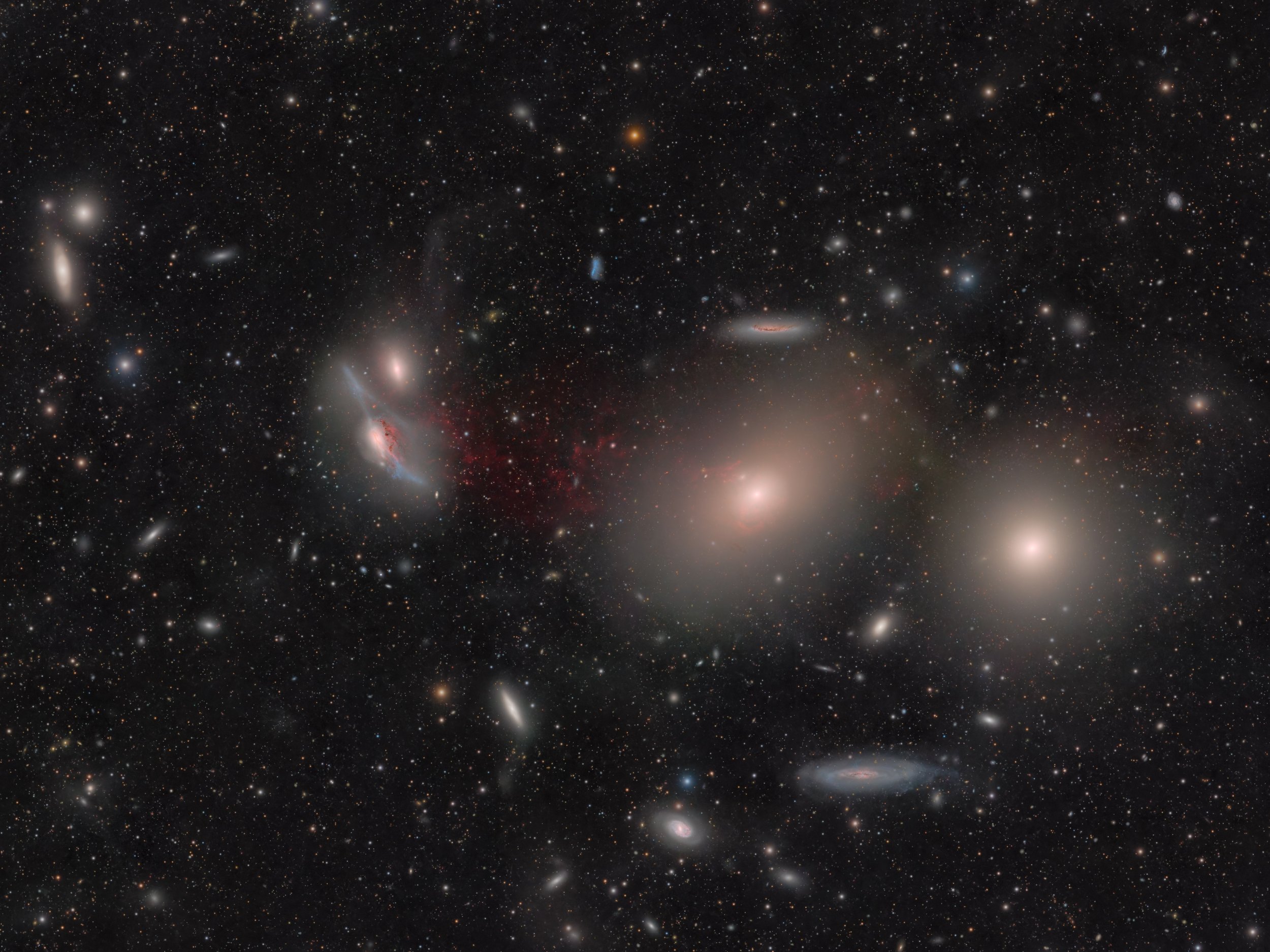Virgo Cluster
Entire Field of View
Bridge Region (rotated ninety)
M87 Core with the Small, Blue Relativistic Jet
About the Subject
This is an image of the center of the Virgo Cluster, a moderate sized cluster of about one thousand five hundred galaxies lying at a relatively close distance of fifty million light years. The Virgo Cluster is the heart of the Virgo Supercluster of galaxies which contains our own Milky Way. The Virgo Cluster is estimated to have a mass of about 1.2 quadrillion stars the size of our sun. The largest, most massive galaxy within the Virgo Cluster is M87, seen here in the upper left of the image. M87 is approximately 132,000 light years across—quite a bit larger than the Milky Way—and is thought to contain several trillion stars compared with the Milky Way’s four hundred billion. The supermassive black hole at the core of M87 has a mass of roughly 5.4 billion Suns, and is famous for being the first ever black hole to have its accretion disk photographed.
In the middle of the image you can see a string of galaxies known as “Markarian’s Chain”. It runs from M84 and M86, giant ellipticals at the bottom of the frame, up through NGC 4438 and NGC 4435, collectively called “The Eyes”, continuing up and to the right of the frame to the barred lenticular galaxy NGC 4477. The top right of the image contains the lovely spiral galaxy M88 with its rich star forming regions and prominent spiral arms. While M88 is part of the Virgo Cluster, it lies in the constellation Coma Berenices.
One of the most interesting features in the photograph is the bridge of red colored gas that appears to connect M86 and NGC 4438 (one of the “Eyes”). This so-called “bridge” of gas between the two galaxies was first reported in 2008 by Kenney et al in the Astrophysical Journal, Volume 687 in which the team describes a filamentary structure of ionized hydrogen gas consistent with a recent collision between the two galaxies in which, the authors propose, cool gas stripped from NGC 4438 during the collision and deposited in its wake is heated by shocks, ram pressure drag, or thermal conduction, producing most of the Hα filaments While the bridge is relatively easy to pick out in the image, it is only visible in very long exposures as the surface brightness is extremely low. That’s why the discovery of this bridge of gas was not made prior to 2008.
M87, the giant elliptical at the upper left of the frame, is a favorite subject for amateur astrophotographers since it contains a very bright relativistic jet, a plasma jet that is ejected away from the accretion disk surrounding the black hole. The incredibly intense magnetic fields of the disk eject the plasma at nearly the speed of light. You can see the bright blue of the plasma jet in the inset image at left. It extends almost five thousand light years from the core of the galaxy.
Due to the long integration time of the image, there are a lot more galaxies in the background than just those contained in the Virgo Cluster itself. The image comfortably reaches magnitude 22.5 or so, allowing galaxies out to several billion light years to be seen. A total of more than 64,000 galaxies are contained within the image, though most of them are too faint to be more than specks. Below, you can find a link that will take you to the annotated image. The galaxy field is far too dense to read the labels, but just glancing at the annotated image will give an idea of just how many galaxies and quasars are actually in the field of view.
About the Image
Four panel mosaic captured between February 24 and May 24, 2025 from Rowe, NM using a 305mm aperture Riccardi-Honders telescope mounted on an AP1100GTO AE german equatorial. The camera used was a QHY600PH monochrome cooled to -10°C. A three nanometer bandpass 50mm x 50mm Chroma filter was used to capture hydrogen alpha emissions (red). The hydrogen data were blended with full color (LRGB) data for the galaxies, stars, gas, and dust to form the image you see here. Total integration time was more than 172 hours across the four panels. A total of ninety-five hours of Hα data across the frame were mated to seventy-seven hours of luminance and color data. The huge amount of Hα was required because the surface brightness on the hydrogen gas is extremely low, requiring long integration time to pull it above the noise floor of the image.



